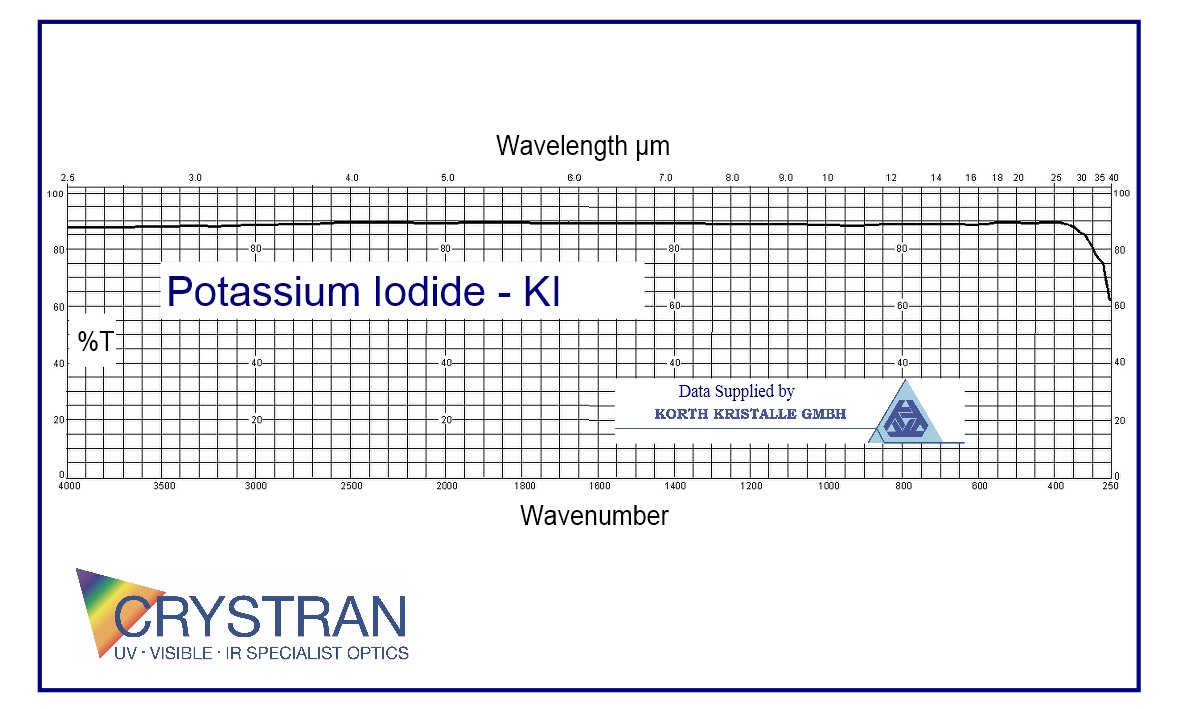

Potassium Iodide KI
Transmission Range
0.38 to 35 μm
Refractive Index
1.6201 at 10 μm (1)
Reflection Loss
10.6% at 10 μm (2 surfaces)
Absorption Coefficient
4.5 x 10-3 cm-1 @ 20 μm (2)
Reststrahlen Peak
82 to 100 μm
dn/dT
-50 x 10-6/°C
dn/dμ = 0
2.1 μm
Density
3.12 g/cc
Melting Point
682°C
Thermal Conductivity
2.1 W m-1 K-1 @ 298 K
Thermal Expansion
43 x 10-6/°C @ 298 K
Hardness
Moh 5
Specific Heat Capacity
313 J Kg-1 K-1
Dielectric Constant
4.94 at 2 MHz
Youngs Modulus (E)
31.49 GPa
Shear Modulus (G)
6.2 GPa
Bulk Modulus (K)
12 GPa
Elastic Coefficients
C11 = 27.4 C12 = 4.3 C44 = 3.7
Apparent Elastic Limit
n/a
Poisson Ratio
n/a
Solubility
127.5g/100g water at 273K
Molecular Weight
166.02
Class/Structure
Cubic FCC, NaCl, Fm3m, (100) cleavage
| µm | No |
|---|---|
| 0.302 | 1.82769 |
| 0.405 | 1.71843 |
| 0.546 | 1.67310 |
| 0.768 | 1.6494 |
| 1.014 | 1.6396 |
| 2.360 | 1.6295 |
| 3.540 | 1.6275 |
| 4.130 | 1.6268 |
| 5.890 | 1.6252 |
| 7.660 | 1.6235 |
| µm | No |
|---|---|
| 8.840 | 1.6218 |
| 10.02 | 1.6201 |
| 11.79 | 1.6172 |
| 12.97 | 1.615 |
| 14.14 | 1.6127 |
| 15.91 | 1.6085 |
| 18.10 | 1.603 |
| 19.00 | 1.5997 |
| 20.00 | 1.5964 |
| 21.00 | 1.593 |
| µm | No |
|---|---|
| 22.00 | 1.5895 |
| 23.00 | 1.5858 |
| 24.00 | 1.5819 |
| 25.00 | 1.5775 |
| 26.00 | 1.5729 |
| 27.00 | 1.5681 |
| 28.00 | 1.5629 |
| 29.00 | 1.5571 |
Potassium Iodide is produced in large ingots by the Kyropoulos growth method. Potassium Iodide cleaves easily. Potassium Iodide is only useful in controlled laboratory conditions as it is very soft and very water soluble.
REFERENCES:
(1) K.Korth, Z.Physik. Vol 84, p677-685 (1933)
(2) H.H.Li, Absorption Coefficients, Int.J.Therm, V1, No. I, 1980
